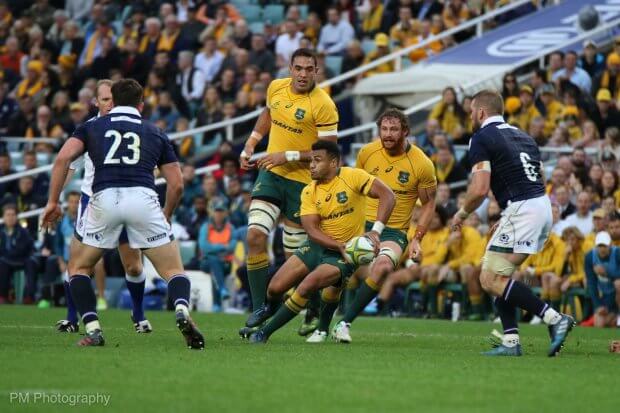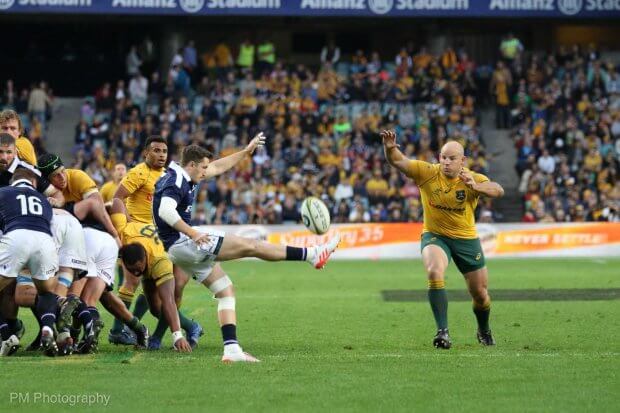Every team has good days and bad days. Performance varies; some things come off sometimes, and not others. That’s inherent in the nature of sport.
But what’s so frustrating about the current run is that fans can see that the Wallabies are encountering the same problems over and over again. If they can’t fix them, the Cheika Wallabies just aren’t going to break out of this trough that they are in.
Defence
The stats from Saturday aren’t awful: 101 of 115 tackles made, for an 88% success rate. That said, European teams at both club and international level are regularly north of 90. The other huge area of improvement is discipline: the Wallabies gave away only 8 penalties, of which 4 were when they had the ball.
But the figures obscure the chronic underlying issues in the defence. The first is the lack of linespeed. Despite repeatedly seeing how effective Northern Hemisphere defences are, the Wallabies refuse to shift away from the current model and embrace a system based on linespeed and the press.
The second issue was one that featured extensively in the match commentary: spacing. The Wallabies essentially move up in inner channels, drift in the midfield, and then push in from the outside. It’s a really weird system that is (in theory) high risk, high reward. It’s not hard for individuals to end up in the wrong place if the attack is varied, or there’s an offload, or a pop off the ground (to name just a few). Specifically, the system causes lots of problems if players are getting stuck in and around the ruck, as they were on Saturday, because the defence becomes exceptionally compressed. This invites teams to spread the ball to the inevitable overlaps that are created. See Scotland’s third try, where they had a three man overlap and Reece Hodge, defending in the 13 role (the key one in this system) ends up having to cover a good 15 metres of horizontal space against multiple attackers.
A more straightforward approach, of course, pushes uniformly out from the ruck, towards the touchline and essentially using it as another defender. Another uses an umbrella defence coupled with real linespeed, as Jake White’s Springboks used to do, which puts lots of pressure on the ball players. The point is: there are many ways to get the job done, but the current system just isn’t working.

Different systems work well against different types of attack, but the Wallabies have one string to their bow, opposition teams understand what they’re doing, and more than a few sides *cough, All Blacks* are more than happy to go over the top to use those wide spaces that are opened up.
The final issue is energy. The Australian defensive line doesn’t look like an international defence. Put simply, there’s no wall. The players aren’t moving up together, let alone together and fast. The difference with the Scottish (or English) lines is visible even to non-experts. The result is that players spend huge amounts of energy putting out fires as they spring up, rather than using less energy to construct a firewall up front.
Strategy
The Wallabies, like all Australian teams, like to play with the ball in hand. So too on Saturday, when they had 56% of possession. Rugby is not won with possession; it’s won with points. The Wallabies also had 62% territory across the match on Saturday and the Scots repeatedly committed penalties in their half. The overall penalty count was 15-8. The Wallabies took precisely one shot at goal (a straightforward one early on, which missed).
Lots of teams are enjoying playing without the ball at the moment and prioritising territory over possession, including England and the All Blacks. Scotland had the worst of both worlds, and Australia was able to force them into committing offences deep in their own half. But when you refuse to take the points – or refuse to develop players who are great kickers at an international level – you simply invite the opposition to infringe with impunity to release the pressure.
It’s true that a 15-8 penalty count might have led other referees to give a yellow in the last ten minutes. It’s also true that Wayne Barnes didn’t seem to pay much attention to Scottish tacklers releasing the tackled player before playing the ball; see the very last penalty of the match, which looks like a World Rugby video illustrating that very offence.

But ultimately you have to be willing to shoot the three, walk back, chill out, and convey a message to the opposition that next time you make a break, they can’t just lie all over the ball and get away with it.
Of course, this really points to a broader issue: the obsession with Plan A. The golden rule in rugby is to always do what the opposition doesn’t want you to do. The corollary of this is that according to the conditions, the team, and the scoreboard, what the opposition doesn’t want you to do *changes*.
The Plan A approach refuses to recognise this fact. And it is a fact. There needs to be an essential acknowledgement that scoring 4 or 5 tries is not the only way to win a test match. Scoring a point or more than your opposition is. And if that means grinding Scotland down, taking 6 shots at goal and kicking four, and winning by a handful, that’s fine. That is the nature of rugby as it is, not how you might want it to be.


